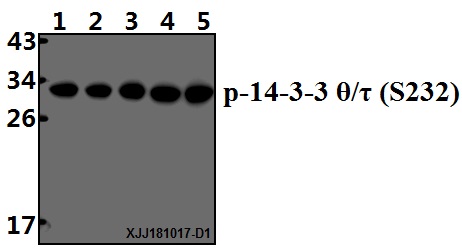14-3-3 theta (YWHAQ) Rabbit Polyclonal Antibody
Frequently bought together (1)
Other products for "YWHAQ"
Specifications
| Product Data | |
| Applications | WB |
| Recommended Dilution | WB: 1:500~1:1000 |
| Reactivities | Human, Mouse, Rat |
| Host | Rabbit |
| Isotype | IgG |
| Clonality | Polyclonal |
| Immunogen | Synthetic phosphopeptide derived from human 14-3-3 θ/τ around the phosphorylation site of Serine 232 |
| Specificity | 14-3-3 θ/τ (phospho-S232) polyclonal antibody detects endogenous levels of 14-3-3 θ/τ protein only when phosphorylated at Ser232. |
| Formulation | Rabbit IgG, 1mg/ml in PBS with 0.02% sodium azide, 50% glycerol, pH7.2 |
| Concentration | 1mg/ml |
| Conjugation | Unconjugated |
| Storage | Store at 4°C short term. Aliquot and store at -22°C long term. Avoid freeze-thaw cycles. |
| Stability | 1 year |
| Predicted Protein Size | ~ 28 kDa |
| Gene Name | tyrosine 3-monooxygenase/tryptophan 5-monooxygenase activation protein theta |
| Database Link | |
| Background | The 14-3-3 family of proteins plays a key regulatory role in signal transduction, checkpoint control, apoptotic and nutrient-sensing pathways. 14-3-3 proteins are highly conserved and ubiquitously expressed. There are at least seven isoforms, β, γ, ε, σ, ζ, τ, and η that have been identified in mammals. The initially described α and δ isoforms are confirmed to be phosphorylated forms of β and ζ, respectively. Through their amino-terminal α helical region, 14-3-3 proteins form homo- or heterodimers that interact with a wide variety of proteins: transcription factors, metabolic enzymes, cytoskeletal proteins, kinases, phosphatases, and other signaling molecules. The interaction of 14-3-3 proteins with their targets is primarily through a phospho-Ser/Thr motif. However, binding to divergent phospho-Ser/Thr motifs, as well as phosphorylation independent interactions has been observed. 14-3-3 binding masks specific sequences of the target protein, and therefore, modulates target protein localization, phosphorylation state, stability, and molecular interactions. 14-3-3 proteins may also induce target protein conformational changes that modify target protein function. Distinct temporal and spatial expression patterns of 14-3-3 isoforms have been observed in development and in acute response to extracellular signals and drugs, suggesting that 14-3-3 isoforms may perform different functions despite their sequence similarities. Several studies suggest that 14-3-3 isoforms are differentially regulated in cancer and neurological syndromes. |
| Synonyms | 14-3-3 protein T-cell; 14-3-3 protein tau; 14-3-3 protein theta; Protein HS1; YWHAQ |
| Note | For research use only, not for use in diagnostic procedure. |
| Reference Data | |
Documents
| Product Manuals |
| FAQs |
| SDS |
{0} Product Review(s)
0 Product Review(s)
Submit review
Be the first one to submit a review
Product Citations
*Delivery time may vary from web posted schedule. Occasional delays may occur due to unforeseen
complexities in the preparation of your product. International customers may expect an additional 1-2 weeks
in shipping.






























































































































































































































































 Germany
Germany
 Japan
Japan
 United Kingdom
United Kingdom
 China
China



